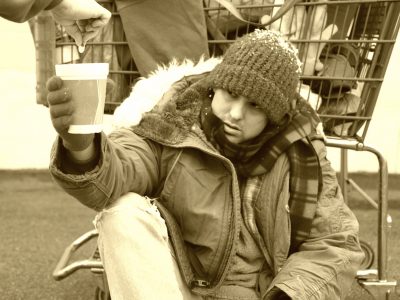Homeless Find a Champion in Canada’s Medicine Hat

MEDICINE HAT, Alberta — Kurt Remple, a toothless, unemployed, struggling alcoholic in Medicine Hat, the curiously named prairie town in Alberta, is a success story of sorts. Five years ago, he was living under a bridge and surviving on free meals from charities.
Today, he lives in a small but tidy one-bedroom apartment in a stucco bungalow.
“It was November and it was getting cold when I met this worker at the Champion Center,” he said, referring to a local establishment that serves breakfast to the poor. “She said, ‘Come to my office and we’ll see if you can find a place.’ ”
Medicine Hat is on the leading edge of a countrywide effort to end homelessness through the “housing first” strategy, developed nearly 25 years ago by a Canadian in New York by which anyone identified as homeless is offered a home without preconditions for sobriety and other self-improvement that keep many people on the street elsewhere.
Alcoholic? Here’s a one-bedroom apartment where you can live — even if you’re still drinking. Drug addict? Here’s a studio with heat and hot water — even if you’re still getting high. Mentally ill? Here’s a place to feel safe and call your own — and where caseworkers can find you.
The theory is that only after people are in stable housing can they begin to address their other challenges.
The strategy has been widely adopted in Europe and Australia. In the United States, it has found its most striking success in reducing homelessness among military veterans in cities like New Orleans, Salt Lake City and Phoenix. But no country has embraced the approach as firmly as Canada.
And nowhere in Canada has as much progress been made as in Medicine Hat, a small energy-rich city on the South Saskatchewan River. In November 2015, the city declared that it had succeeded in ending homelessness, bringing accolades and attention from all over the world.
But Medicine Hat’s claim points to the fuzzy logic of the problem: The end of homelessness is a state, not a moment. There will always be people who become homeless, and there will always be people who prefer to remain homeless, even in Medicine Hat.
“I like moving around — I can’t explain it,” said Gordon Thompson, a cheerful homeless man of 72, sitting in a Medicine Hat Salvation Army day room where clusters of people gather to pass the time and get a hot meal. He jokes with the caseworkers who come by imploring him to accept a home but stays instead in shelters or on the street, one among a hard-core cohort that shuns assistance.
As elsewhere in the world, Canada’s homelessness problem grew in recent decades as rising rents pushed the country’s most vulnerable citizens into the streets. The oil boom fed the real estate bubble in Alberta.
Calgary, the center of Alberta’s energy industry, had the worst homelessness in the province. In 2006, the province gave the city money to test the housing first approach, which had been pioneered more than a decade earlier by a Canadian psychologist, Sam Tsemberis, while he was working in New York.
With parallel projects popping up in British Columbia and Ontario, the Mental Health Commission of Canada got involved, lobbying for federal money to study the strategy. The commission started a clinical trial in five cities across Canada — Vancouver, Winnipeg, Toronto, Montreal and Moncton — in which 2,200 homeless people with either mental illness or an addiction were randomly assigned to either housing first or treatment as usual.
The results were startling, validating the housing first model and showing that the cost of housing the homeless was far less than the cost of the emergency services needed by the homeless while they were living on the street.
“The reduction in days in jail alone pays for the program,” said Jaime Rogers, a Medicine Hat housing official. She cited studies that said the average homeless person costs taxpayers 120,000 Canadian dollars a year, or $91,600, in services, while it costs just 18,000 Canadian dollars a year, or $13,740, to house someone and provide the necessary retention support.
That kind of evidence persuaded the conservative government of former Prime Minister Stephen Harper to pursue housing first as a national policy.
“This is where it went to a scale that I have not seen in any other country,” Dr. Tsemberis said in a telephone interview.
Under Canada’s subsequent Homeless Partnering Strategy, the federal government now distributes about 176 million Canadian dollars a year, or about $134 million, among 61 communities to fund services for the homeless. About 40 percent of that money must be spent on housing first interventions.
Seven Alberta cities — Calgary, Edmonton, Lethbridge, Grande Prairie, Red Deer, Wood Buffalo and Medicine Hat — formed a loose coalition and in 2007 each wrote its own 10-year plan to end homelessness. The province now spends more than 83 million Canadian dollars, or about $63 million, a year to carry out the plans, and came up with a 10-year plan of its own.
Progress has been promising. In 2014, when Alberta conducted a “point in time” count — giving a snapshot of people who are homeless on a particular night — the total in the seven cities studied was 6,663. In 2016, the number had fallen nearly 20 percent, to 5,378.
Results in Medicine Hat were even more striking: The number of homeless counted fell by nearly half to 33 from 61. The number of participants in the housing first program, meanwhile, doubled to 120.
Medicine Hat leapt ahead, in part, because the problem is more manageable here. It is easier to deal with homelessness in a town of 63,000, where social workers know the names of almost everyone who is down and out. It is also easier when members from the agencies working on the problem are so few that they can sit down around a table.
But Medicine Hat has another advantage that could point the way for other cities: a centralized office that manages both housing stock and support programs. The Homeless and Housing Development Department of the Medicine Hat Community Housing Society is led by Ms. Rogers.
Recognizing that some people will always lose their homes, and with no national consensus of what “ending homelessness” means, Ms. Rogers and her team came up with their own definition: In Medicine Hat, it means connecting anyone identified as homeless with a caseworker and putting him or her on a waiting list for a housing program within 10 days.
That turned out to be a stroke of public relations genius, because when they reached their goal, word that Medicine Hat had “ended homelessness” ricocheted from Argentina to Germany to Japan. The once-skeptical mayor, whose office plays only a marginal role in the plan, has since given as many as 200 interviews on the subject to news media from all over the world.
The question, of course, is: How long do people remain homeless before being housed? Because of adequate federal and provincial funding and a good supply of local housing, few people in Medicine Hat remain truly homeless for more than a few months, Ms. Rogers said.
She added that it took time to help homeless people get their papers straightened out and arrange for government assistance. Then, they are offered at least three potential homes. Some prefer to wait in a shelter until they are happy with what is available.
Ms. Rogers said it cost less in the long run if the process was slow and deliberate because the goal is to house people permanently rather than rush them to unsuitable housing and have them return to the street.
Of course, a housing first strategy in larger cities becomes exponentially more complex, cautioned Dr. Stefan Kertesz, an associate professor at the University of Alabama at Birmingham School of Medicine, who has studied housing first challenges in the United States.
Only some major metropolitan centers are equipped with the leadership, manpower or structure necessary to coordinate a multiagency effort.
“Cities with tight housing markets need a very substantial amount of work, both in terms of front-line staff and organizational leadership, put toward recruiting landlords and even rehabbing buildings,” Dr. Kertesz said by email. “It means a major organizational undertaking with all pistons firing.”
In Canada, there is now a move to define on a national scale what it means to end homelessness, providing a benchmark for success.
Alina Turner, a fellow at the University of Calgary’s School of Public Policy and one of the lead researchers pushing for a definition, said current programs should aim for “functional zero,” which recognizes that there will always be some people without homes.
Under the currently proposed definition, functional zero would mean a 90 percent decrease in people experiencing homelessness in a community.
“Housing is the easy part,” said Ms. Rogers, who acknowledged that by Dr. Turner’s definition, Medicine Hat still had a way to go. “Keeping them housed will always be the difficult part.”
Indeed, Mr. Remple, sitting in his sparsely furnished apartment, said this was the fifth place he had lived in during the five years since he connected with the housing first program.
“I kept taking in homeless friends,” he said blankly. “I’d have two or four people living and drinking and partying with me until I’d get evicted.”
Frustrating as such people might be, most eventually manage to settle down, social workers say. The stability of a home allows people to gradually address their problems.
Mr. Remple’s caseworker, Allysa Larmor, said he had been sober since January and seems determined to change his ways. She has helped mediate with his landlord and connect him with services like addiction counseling and a food bank, and she will soon start working with him on developing “meaningful daily activities” to fill the time that was once taken up drinking.
An earlier version of this article misspelled the given name of a former Canadian prime minister. He is Stephen Harper, not Steven. And an earlier version of a picture caption with this article misspelled the surname of an alcoholic who is taking part in the housing program. He is Kurt Remple, not Rempel.
An earlier version of this article misstated the equivalent United States dollar amount for 176 million Canadian dollars. It is $134 million, not $134.
An article on Wednesday about Canada’s “housing first” strategy to end homelessness, which provides housing without preconditions for sobriety or other self-improvement and is showing great promise in Medicine Hat, a small city in Alberta Province, erroneously attributed a distinction to Alberta. While the province conducted a “point in time” head count — a snapshot of people who are homeless on a particular night — in 2014, it was not the first such count in Canada. (A point-in-time count was done as far back as 2005, by Vancouver.)
Source: The New York Times


